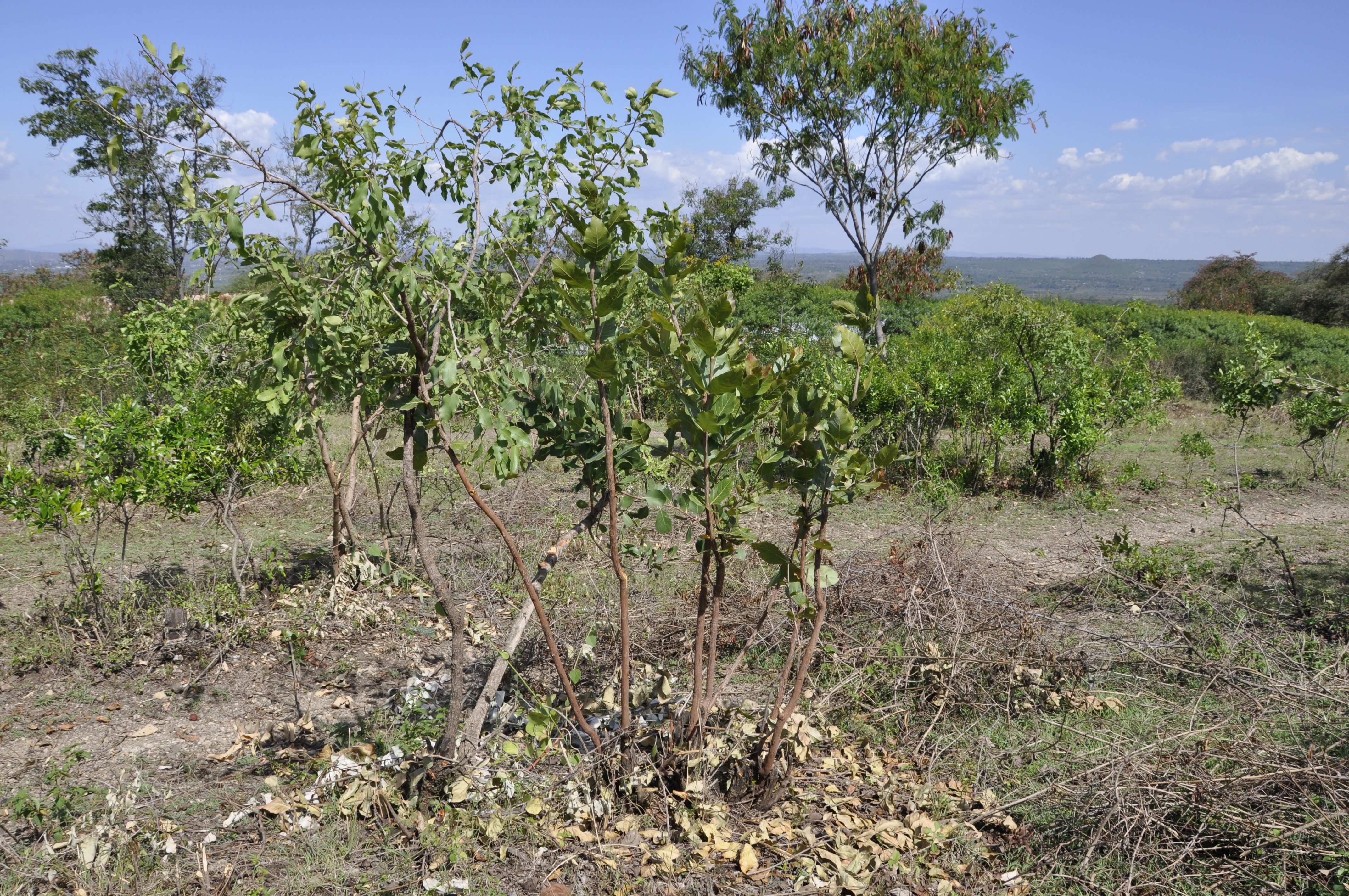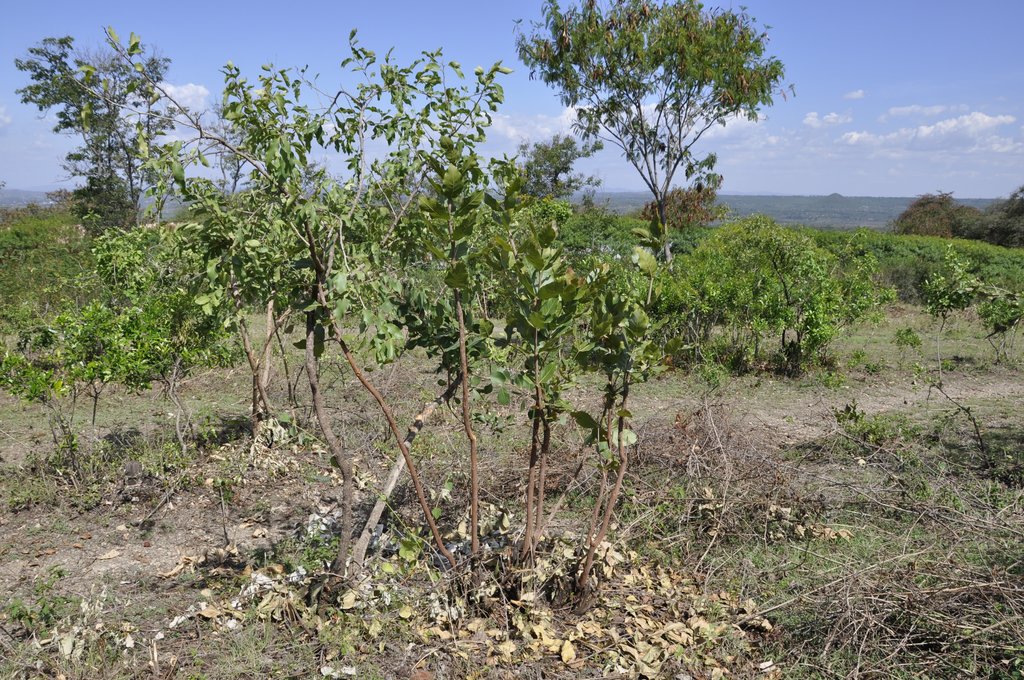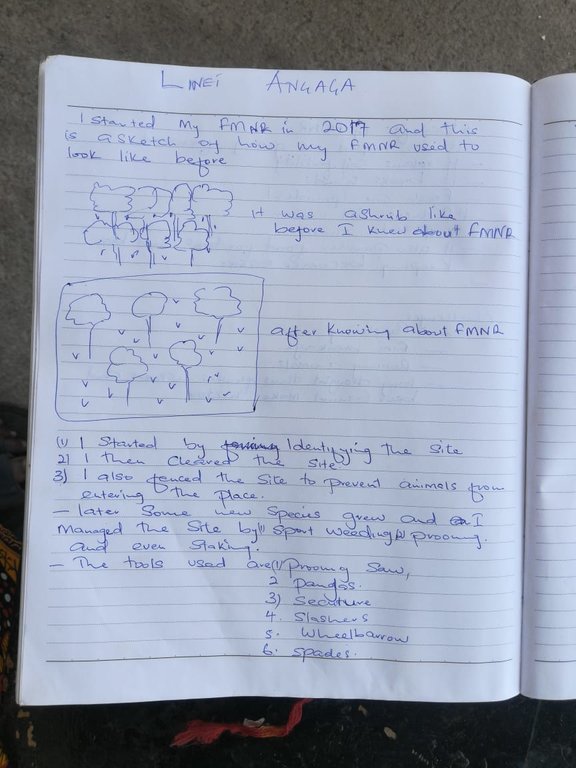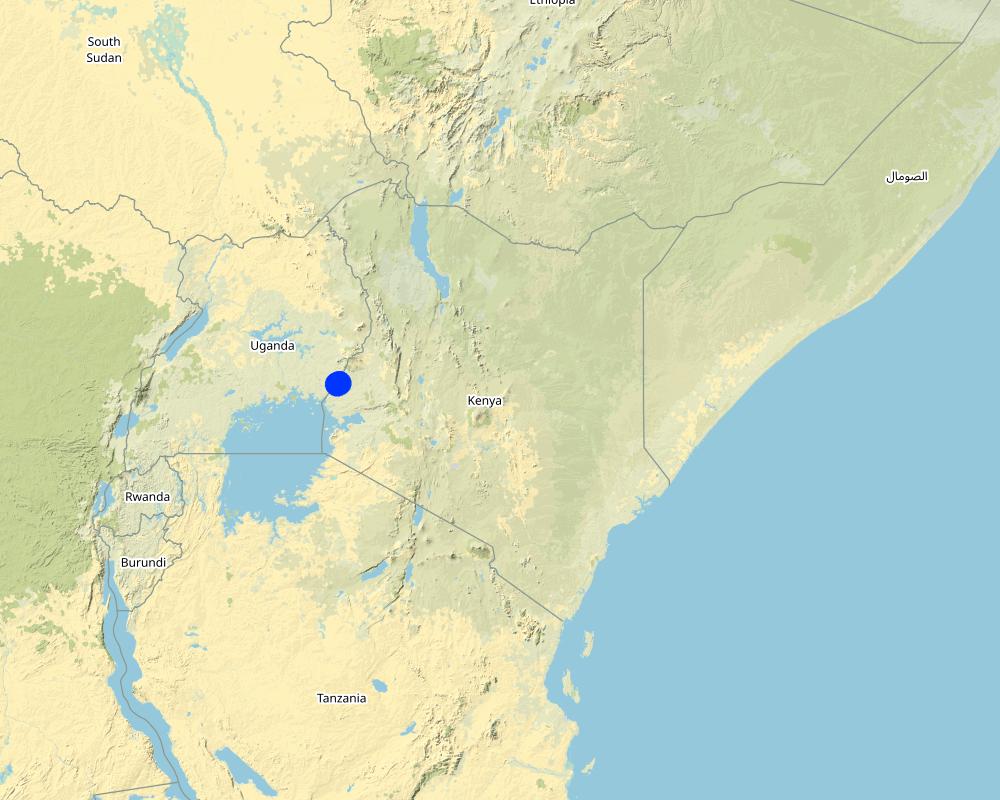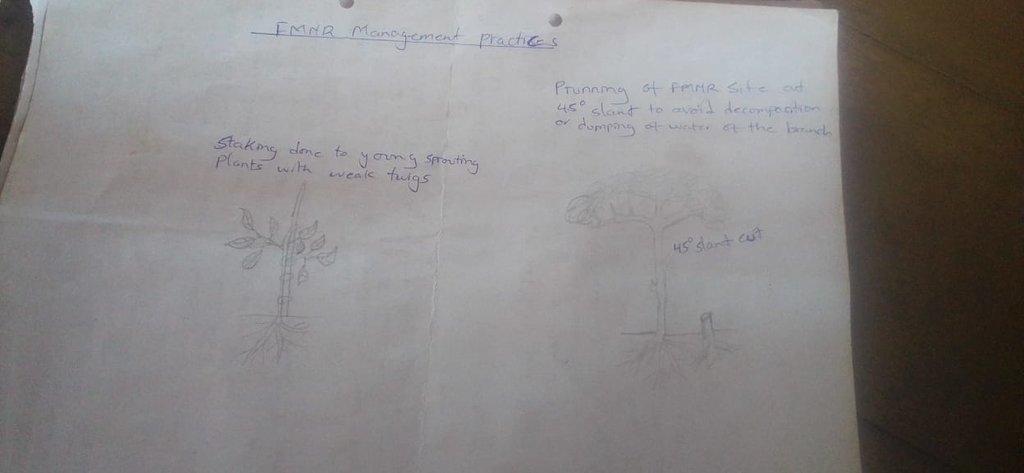Farmer managed natural regeneration in smallholdings [Kenya]
- Creation:
- Update:
- Compiler: Grace Koech
- Editor: –
- Reviewers: William Critchley, Rima Mekdaschi Studer
FMNR
technologies_6600 - Kenya
View sections
Expand all Collapse all1. General information
1.2 Contact details of resource persons and institutions involved in the assessment and documentation of the Technology
Key resource person(s)
land user:
Sabina Atieno
lead farmer
Kenya
Name of project which facilitated the documentation/ evaluation of the Technology (if relevant)
Reversing land degradation in Africa by scaling-up Evergreen Agriculture (Regreening Africa)Name of the institution(s) which facilitated the documentation/ evaluation of the Technology (if relevant)
International Centre for Research in Agroforestry (ICRAF) - Kenya1.3 Conditions regarding the use of data documented through WOCAT
The compiler and key resource person(s) accept the conditions regarding the use of data documented through WOCAT:
Ja
1.4 Declaration on sustainability of the described Technology
Is the Technology described here problematic with regard to land degradation, so that it cannot be declared a sustainable land management technology?
Nee
Comments:
FMNR has been embraced by the local community as they consider it low cost and products from FMNR are utilized for various livelihood activities such as woodfuel for household use and surplus for sale, beekeeping is practiced within the plots: passion fruits are integrated also - climbing on frameworks of prunings.
2. Description of the SLM Technology
2.1 Short description of the Technology
Definition of the Technology:
Farmer managed natural regeneration (FMNR) has been embraced by the local community as they consider it a low cost method of establishing agroforestry, and products are utilized for various livelihood activities such as woodfuel for household use and surplus for sale, beekeeping is practiced within the plots: passion fruits are integrated also - climbing on frameworks of prunings.
2.2 Detailed description of the Technology
Description:
Farmer managed natural regeneration (FMNR) involves helping naturally regenerating trees to grow at the homestead - in cropland or within enclosure. FMNR begins with assessment of the land to ascertain the potential to practice the technology. Plots that have shrubs or stumps are selected. Management by thinning is practiced to provide a suitable density to allow prolific growth. The offcuts and twigs from clearing the shrub can be used as mulch, stakes for beans or passion fruits, or as wood fuel. Other techniques used includes propping to support weak stems and protection of site to avoid interference by human and livestock. In Homabay county, Western Kenya, farmer manage their plots by thinning, supporting stems and pruning. Species are regenerated using protection of naturally seeded trees, including Acacia spp, Grewia bicolor, Balanities aegyptiaca, Psidium guajava, Combretum collinum, Markamia lutea, Thevetia peruviana, Albizia coriara and Rhus spp. FMNR has been embraced by the local community as they consider it a low cost way of establishing agroforestry and products are utilized for various livelihood activities such as woodfuel for household use and surplus for sale, beekeeping is practiced within the plots: passion fruits are integrated also - climbing on frameworks of prunings.
2.3 Photos of the Technology
2.4 Videos of the Technology
Comments, short description:
we can only get the youtube link to the video
https://youtube.com/clip/Ugkxk1nImuwSZVktgpAkvKwotlFKDo7s6_-8
Date:
14/12/2022
Location:
Migori
Name of videographer:
@manathaproductions
2.5 Country/ region/ locations where the Technology has been applied and which are covered by this assessment
Country:
Kenya
Region/ State/ Province:
Homabay and Migori counties
Specify the spread of the Technology:
- evenly spread over an area
If precise area is not known, indicate approximate area covered:
- 1-10 km2
Is/are the technology site(s) located in a permanently protected area?
Nee
Map
×2.6 Date of implementation
Indicate year of implementation:
2018
If precise year is not known, indicate approximate date:
- less than 10 years ago (recently)
2.7 Introduction of the Technology
Specify how the Technology was introduced:
- through land users' innovation
- as part of a traditional system (> 50 years)
- through projects/ external interventions
Comments (type of project, etc.):
Regreening project or project on restoration of degraded landscape combined with traditional agroforestry.
3. Classification of the SLM Technology
3.1 Main purpose(s) of the Technology
- improve production
- reduce, prevent, restore land degradation
- conserve ecosystem
- adapt to climate change/ extremes and its impacts
- create beneficial economic impact
3.2 Current land use type(s) where the Technology is applied
Land use mixed within the same land unit:
Ja
Specify mixed land use (crops/ grazing/ trees):
- Agro-silvopastoralism

Cropland
- Annual cropping
- Perennial (non-woody) cropping
- Tree and shrub cropping
Annual cropping - Specify crops:
- cereals - maize
- cereals - millet
- cereals - sorghum
- legumes and pulses - beans
- medicinal/ aromatic/ pesticidal plants and herbs
Annual cropping system:
Cassava/potato/manioc - maize/sorghum/millet
Perennial (non-woody) cropping - Specify crops:
- banana/plantain/abaca
- fodder crops - legumes, clover
- natural grasses
Tree and shrub cropping - Specify crops:
- avocado
- citrus
- fodder trees (Calliandra, Leucaena leucocephala, Prosopis, etc.)
- fruits, other
Number of growing seasons per year:
- 2
Specify:
March to May, October to December
Is intercropping practiced?
Ja
If yes, specify which crops are intercropped:
Maize and beans
sweet potatoes and vegetables
groundnuts, indigenous vegetables and cassava
Is crop rotation practiced?
Nee

Grazing land
Intensive grazing/ fodder production:
- Cut-and-carry/ zero grazing
- Improved pastures
Animal type:
- beekeeping, apiculture
- cattle - dairy and beef (e.g. zebu)
- fish
- goats
- poultry
- sheep
Is integrated crop-livestock management practiced?
Ja
If yes, specify:
Farmers utilize animal manure for soil amendment, the systems provide a buffer incase of crop failure
Products and services:
- economic security, investment prestige
- eggs
- manure as fertilizer/ energy production
- meat
- milk
Species:
beekeeping, apiculture
Count:
5
Species:
cattle - dairy and beef (e.g. zebu)
Count:
4
Species:
fish
Count:
10
Species:
goats
Count:
4
Species:
poultry
Count:
10
Comments:
FMNR is practiced on cropping field where farmers encourage naturally growing trees of high value to regenerate alongside the crops. within the grazing field, pruning and thinning of naturally regenerating trees is done to allow grass to grow. in some cases the grazing field are enclosed and farmers can only cut and carry the grasses especially when the trees/ seedlings are young.
3.3 Has land use changed due to the implementation of the Technology?
Has land use changed due to the implementation of the Technology?
- No (Continue with question 3.4)
Land use mixed within the same land unit:
Ja
Specify mixed land use (crops/ grazing/ trees):
- Agro-silvopastoralism

Cropland
- Annual cropping
Annual cropping - Specify crops:
- cereals - maize
Is intercropping practiced?
Ja
If yes, specify which crops are intercropped:
Maize, beans
Is crop rotation practiced?
Nee
Comments:
The land is used in the same way before and after the technology, the difference is the productivity of the land that has improved as a result of implementation of the technology. for example with increased availability of forage, farmers have witnessed milk production that translate to more food for the household and surplus for market that also support other livelihoods such as access to quality seedlings.
3.4 Water supply
Water supply for the land on which the Technology is applied:
- rainfed
Comments:
Most farmers do not irrigate the trees that regenerate naturally, they are mainly rain-fed systems.
3.5 SLM group to which the Technology belongs
- agroforestry
3.6 SLM measures comprising the Technology

agronomic measures
- A1: Vegetation/ soil cover

vegetative measures
- V1: Tree and shrub cover
- V2: Grasses and perennial herbaceous plants
- V4: Replacement or removal of alien/ invasive species

structural measures
- S1: Terraces
- S2: Bunds, banks
- S10: Energy saving measures

management measures
- M2: Change of management/ intensity level
- M3: Layout according to natural and human environment
Comments:
The choice of the measure depends on the level of degradation. in severely degraded areas a combination of measures are integrated.
3.7 Main types of land degradation addressed by the Technology

soil erosion by water
- Wt: loss of topsoil/ surface erosion
- Wg: gully erosion/ gullying

soil erosion by wind
- Et: loss of topsoil

chemical soil deterioration
- Cn: fertility decline and reduced organic matter content (not caused by erosion)

physical soil deterioration
- Ps: subsidence of organic soils, settling of soil

biological degradation
- Bc: reduction of vegetation cover
- Bh: loss of habitats
- Bq: quantity/ biomass decline
- Bs: quality and species composition/ diversity decline
- Bl: loss of soil life

water degradation
- Ha: aridification
- Hs: change in quantity of surface water
- Hg: change in groundwater/aquifer level
Comments:
Another form of degradation managed using the technology is invasive species management by thinning out unwanted species or uprooting.
3.8 Prevention, reduction, or restoration of land degradation
Specify the goal of the Technology with regard to land degradation:
- restore/ rehabilitate severely degraded land
- adapt to land degradation
Comments:
The technology is promoted to reverse effects of land degradation and adapt to changing patterns as a result of the degradation. for example the area enclosure is able to regenerate within the prevailing environmental conditions.
4. Technical specifications, implementation activities, inputs, and costs
4.1 Technical drawing of the Technology
Technical specifications (related to technical drawing):
The height of the seedlings to be regenerated ranges from as low as ground level to fully grown trees, the spacing between the trees is 10m apart in crop land and 5m in grazing field. .
Author:
William Gumbo, farmer Homabay county
Date:
03/04/2023
4.2 General information regarding the calculation of inputs and costs
Specify how costs and inputs were calculated:
- per Technology area
Indicate size and area unit:
1 acre
If using a local area unit, indicate conversion factor to one hectare (e.g. 1 ha = 2.47 acres): 1 ha =:
0.4 ha
Specify currency used for cost calculations:
- USD
Indicate average wage cost of hired labour per day:
$3
4.3 Establishment activities
| Activity | Timing (season) | |
|---|---|---|
| 1. | Survey land | dry season |
| 2. | Take an inventory of available species and their priority uses | dry season |
| 3. | generate a priority use list for the farm | dry season |
| 4. | generate a preferred species list | dry season |
| 5. | Mark and remove the unwanted species | dry season |
| 6. | select species and stumps to be regenerated | dry season |
| 7. | manage the stumps/stems by removing unwated stumps,thinning to remain with manageable density | dry season |
| 8. | keep three to five stems on each of the selected species and stumps | onset of the rain season |
| 9. | Manage the selected by pruning ofside branches, protection by fencing, utilize the prunning and coppices as firewood, make biochar, stakes for vegetable farming, compost making, construction work etc | raining season |
| 10. | allow the trees to grow for preferred use, periodically pruning is required | 2-6 months |
Comments:
Where the trees regenerated has low density or diversity or the high value/preferred species are not available consider enrichment planting. in areas where FMNR is not feasible resort to enrichment planting. other technologies such as grass reseeding, soil water conservation could be implemented alongside FMNR.
4.4 Costs and inputs needed for establishment
| Specify input | Unit | Quantity | Costs per Unit | Total costs per input | % of costs borne by land users | |
|---|---|---|---|---|---|---|
| Labour | Land survey and inventory of species | person day | 1.0 | 3.0 | 3.0 | 100.0 |
| Labour | marking and removing unwanted species | person day | 1.0 | 3.0 | 3.0 | 100.0 |
| Labour | marking and regenerating the preferred species | person day | 3.0 | 3.0 | 9.0 | 100.0 |
| Labour | managing regenerated trees | person day | 1.0 | 3.0 | 3.0 | 100.0 |
| Equipment | machete | 100.0 | ||||
| Equipment | axe | 100.0 | ||||
| Equipment | file | 100.0 | ||||
| Equipment | fork hoe | 100.0 | ||||
| Equipment | hoe | 100.0 | ||||
| Equipment | wheelbarrow | 100.0 | ||||
| Equipment | rake | 100.0 | ||||
| Equipment | pruning saw | 100.0 | ||||
| Construction material | use locally available, dead fence | |||||
| Total costs for establishment of the Technology | 18.0 | |||||
| Total costs for establishment of the Technology in USD | 18.0 | |||||
Comments:
Where the farmer decide to do enrichment planting, permanent fencing, grass reseeding the cost is higher that what is projected here. the cost for the first year is high, subsequent years the cost is low. The household use available equipment to manage and regenerate the trees.
4.5 Maintenance/ recurrent activities
| Activity | Timing/ frequency | |
|---|---|---|
| 1. | pruning and removal of emerging species | twice per year |
Comments:
Maintenance depend on the availability of rainfall that determine how faster the trees establishes.
4.6 Costs and inputs needed for maintenance/ recurrent activities (per year)
| Specify input | Unit | Quantity | Costs per Unit | Total costs per input | % of costs borne by land users | |
|---|---|---|---|---|---|---|
| Labour | pruning and removing unwanted | 1 | 1.0 | 3.0 | 3.0 | 100.0 |
| Total costs for maintenance of the Technology | 3.0 | |||||
| Total costs for maintenance of the Technology in USD | 3.0 | |||||
Comments:
Maintenance cost is lower since it is done periodically and trees establishes at different growth rates.
4.7 Most important factors affecting the costs
Describe the most determinate factors affecting the costs:
1) density of the species
2) frequency and intensity of the rains
3) level of degradation
4) management objectives
5. Natural and human environment
5.1 Climate
Annual rainfall
- < 250 mm
- 251-500 mm
- 501-750 mm
- 751-1,000 mm
- 1,001-1,500 mm
- 1,501-2,000 mm
- 2,001-3,000 mm
- 3,001-4,000 mm
- > 4,000 mm
Agro-climatic zone
- sub-humid
FMNR is mainly a dry land practice but can also be practiced on humid areas where existing trees are managed by pruning and thinning to manage density.
5.2 Topography
Slopes on average:
- flat (0-2%)
- gentle (3-5%)
- moderate (6-10%)
- rolling (11-15%)
- hilly (16-30%)
- steep (31-60%)
- very steep (>60%)
Landforms:
- plateau/plains
- ridges
- mountain slopes
- hill slopes
- footslopes
- valley floors
Altitudinal zone:
- 0-100 m a.s.l.
- 101-500 m a.s.l.
- 501-1,000 m a.s.l.
- 1,001-1,500 m a.s.l.
- 1,501-2,000 m a.s.l.
- 2,001-2,500 m a.s.l.
- 2,501-3,000 m a.s.l.
- 3,001-4,000 m a.s.l.
- > 4,000 m a.s.l.
Indicate if the Technology is specifically applied in:
- not relevant
Comments and further specifications on topography:
Topography has no effect on FMNR
5.3 Soils
Soil depth on average:
- very shallow (0-20 cm)
- shallow (21-50 cm)
- moderately deep (51-80 cm)
- deep (81-120 cm)
- very deep (> 120 cm)
Soil texture (topsoil):
- coarse/ light (sandy)
- medium (loamy, silty)
Soil texture (> 20 cm below surface):
- coarse/ light (sandy)
- medium (loamy, silty)
Topsoil organic matter:
- medium (1-3%)
- low (<1%)
If available, attach full soil description or specify the available information, e.g. soil type, soil PH/ acidity, Cation Exchange Capacity, nitrogen, salinity etc.
Soil information is not available
5.4 Water availability and quality
Ground water table:
5-50 m
Availability of surface water:
medium
Water quality (untreated):
good drinking water
Water quality refers to:
both ground and surface water
Is water salinity a problem?
Nee
Is flooding of the area occurring?
Nee
Comments and further specifications on water quality and quantity:
FMNR rely on natural environmental conditions
5.5 Biodiversity
Species diversity:
- medium
Habitat diversity:
- medium
Comments and further specifications on biodiversity:
Agrobiodiversity increases with FMNR/ Agroforestry
5.6 Characteristics of land users applying the Technology
Sedentary or nomadic:
- Sedentary
Market orientation of production system:
- mixed (subsistence/ commercial)
Off-farm income:
- 10-50% of all income
Relative level of wealth:
- average
Individuals or groups:
- individual/ household
- groups/ community
Level of mechanization:
- manual work
- animal traction
Gender:
- women
- men
Age of land users:
- youth
- middle-aged
5.7 Average area of land used by land users applying the Technology
- < 0.5 ha
- 0.5-1 ha
- 1-2 ha
- 2-5 ha
- 5-15 ha
- 15-50 ha
- 50-100 ha
- 100-500 ha
- 500-1,000 ha
- 1,000-10,000 ha
- > 10,000 ha
Is this considered small-, medium- or large-scale (referring to local context)?
- small-scale
- medium-scale
5.8 Land ownership, land use rights, and water use rights
Land ownership:
- communal/ village
- individual, titled
Land use rights:
- communal (organized)
- individual
Water use rights:
- communal (organized)
- individual
Are land use rights based on a traditional legal system?
Ja
5.9 Access to services and infrastructure
health:
- poor
- moderate
- good
education:
- poor
- moderate
- good
technical assistance:
- poor
- moderate
- good
employment (e.g. off-farm):
- poor
- moderate
- good
markets:
- poor
- moderate
- good
energy:
- poor
- moderate
- good
roads and transport:
- poor
- moderate
- good
drinking water and sanitation:
- poor
- moderate
- good
financial services:
- poor
- moderate
- good
6. Impacts and concluding statements
6.1 On-site impacts the Technology has shown
Socio-economic impacts
Production
crop production
fodder production
wood production
forest/ woodland quality
non-wood forest production
risk of production failure
product diversity
production area
land management
energy generation
Comments/ specify:
well managed FMNR farms in Migori and Homabay increase availability of timber and non timber products on farms.
Water availability and quality
drinking water availability
drinking water quality
water availability for livestock
Comments/ specify:
effect of FMNR on water resources indicated increase as shown within the nyatike mirema hills where over time rivers that had disappeared are restore and water access increased in the area. similarly Homabay has received increased rainfall as compared to previous years due to increased tree cover with trees of varying growth heights.
water quality for livestock
irrigation water availability
irrigation water quality
demand for irrigation water
Income and costs
expenses on agricultural inputs
farm income
Comments/ specify:
Business such as beekeeping and firewood bulking is practised within the FMNR plots generating additional income for the homestead.
diversity of income sources
Comments/ specify:
increased, FMNR based enterprises developed for example beekeeping, firewood
economic disparities
Comments/ specify:
data not documented
workload
Comments/ specify:
time to access firewood which is the main economic activity in the area due to reliance of it for cooking is saved as pruning from the plot serve this purpose and surplus sold hence more time for other livelihood activities.
Socio-cultural impacts
food security/ self-sufficiency
Comments/ specify:
some plots are managed communally, this bring people together to exchange ideas and conversation as they working together on the plots building the social cohesion within the community, additionally, community receive more people visiting their sites to learn more about the practice which comes with some prestige for the community.
health situation
Comments/ specify:
improved due to access to more products and income increasing purchasing power of the community.
land use/ water rights
Comments/ specify:
land and water rights applies to all community members
cultural opportunities
Comments/ specify:
FMNR practice bring people together that present many opportunities to interact and promote collective action.
recreational opportunities
Comments/ specify:
increased as people are visiting the demo farms
community institutions
Comments/ specify:
strengthened communities formed groups to enable them work together to better their community, access financial support and market their products jointly
national institutions
Comments/ specify:
FMNR practises links different actors together during trainings, field days and demonstration on practise. This approach has contributed to increased knowledge and skills and interaction between the local and national institutions.
SLM/ land degradation knowledge
Comments/ specify:
knowledge products on FMNR practice in Kenya developed, training materials prepared, several trainings conducted on FMNR.
conflict mitigation
Comments/ specify:
N/A
situation of socially and economically disadvantaged groups
Comments/ specify:
N/A
Ecological impacts
Water cycle/ runoff
water quantity
Comments/ specify:
restoration of water sources due increased ground water as a result of restoration
water quality
Comments/ specify:
N/A
harvesting/ collection of water
Comments/ specify:
more water accessed due to increased volumes of water due to more rains
surface runoff
Comments/ specify:
increased vegetation cover reduce surface flow in the intervention areas
excess water drainage
Comments/ specify:
N/A
groundwater table/ aquifer
Comments/ specify:
see above
evaporation
Comments/ specify:
higher water conservation
Soil
soil moisture
Comments/ specify:
more water infiltrate to soil and stored at the root zone
soil cover
Comments/ specify:
more cover crops, foliage from leaf fall increases soil cover
soil loss
Comments/ specify:
soil is not exposed for ease of erosion
soil accumulation
Comments/ specify:
N/A
soil crusting/ sealing
Comments/ specify:
N/A
soil compaction
Comments/ specify:
N/A
nutrient cycling/ recharge
Comments/ specify:
with increased water availability, reduced soil temperature nutrient cycling increased
salinity
Comments/ specify:
N/A
soil organic matter/ below ground C
Comments/ specify:
N/A
acidity
Comments/ specify:
N/A
Biodiversity: vegetation, animals
Vegetation cover
biomass/ above ground C
Comments/ specify:
N/A
plant diversity
invasive alien species
Comments/ specify:
N/A
animal diversity
Comments/ specify:
N/A
beneficial species
habitat diversity
pest/ disease control
Comments/ specify:
N/A
Climate and disaster risk reduction
flood impacts
Comments/ specify:
N/A
landslides/ debris flows
Comments/ specify:
N/A
drought impacts
impacts of cyclones, rain storms
Comments/ specify:
N/A
emission of carbon and greenhouse gases
Comments/ specify:
N/A
fire risk
wind velocity
micro-climate
Specify assessment of on-site impacts (measurements):
FMNR increases diversity on-site. Issues of water, carbon, soil were not assessed in the study.
6.2 Off-site impacts the Technology has shown
Specify assessment of off-site impacts (measurements):
Offsite benefits of FMNR were not assessed.
6.3 Exposure and sensitivity of the Technology to gradual climate change and climate-related extremes/ disasters (as perceived by land users)
Gradual climate change
Gradual climate change
| Season | increase or decrease | How does the Technology cope with it? | |
|---|---|---|---|
| annual rainfall | increase | well |
Comments:
land users are conversant to temperature and rainfall as the main climate related issues.
6.4 Cost-benefit analysis
How do the benefits compare with the establishment costs (from land users’ perspective)?
Short-term returns:
slightly positive
Long-term returns:
very positive
How do the benefits compare with the maintenance/ recurrent costs (from land users' perspective)?
Short-term returns:
slightly negative
Long-term returns:
very positive
6.5 Adoption of the Technology
- > 50%
Of all those who have adopted the Technology, how many did so spontaneously, i.e. without receiving any material incentives/ payments?
- 51-90%
6.6 Adaptation
Has the Technology been modified recently to adapt to changing conditions?
Nee
6.7 Strengths/ advantages/ opportunities of the Technology
| Strengths/ advantages/ opportunities in the land user’s view |
|---|
| user friendly and complementary to other land use activities |
| cost effective after the first investment |
| high potential for scaling |
| Strengths/ advantages/ opportunities in the compiler’s or other key resource person’s view |
|---|
| preserve biological diversity |
| start with the knowledge that farmers posses |
| build on the local knowledge of the farmers |
6.8 Weaknesses/ disadvantages/ risks of the Technology and ways of overcoming them
| Weaknesses/ disadvantages/ risks in the land user’s view | How can they be overcome? |
|---|---|
| high cost of initial investment | form farmer cooperatives to access credit |
| limited available natural regenerants | compliment with enrichment planting |
| sometimes available stumps are not the preferred species | compliment with enrichment planting |
| Weaknesses/ disadvantages/ risks in the compiler’s or other key resource person’s view | How can they be overcome? |
|---|---|
| FMNR policy missing | Support policy reforms to include FMNR |
| practiced mainly in the rangeland where land tenure is communal | Strengthening existing community structures |
| slow growing of the indigenous species making it less preferred by the farmers | compliment with fast growing high value trees |
7. References and links
7.1 Methods/ sources of information
- field visits, field surveys
9
- compilation from reports and other existing documentation
When were the data compiled (in the field)?
13/12/2022
7.2 References to available publications
Title, author, year, ISBN:
10.Wanjira, E.O., Muriuki, J. & Ojuok, I. (2020). Farmer Managed Natural Regeneration for Kenya: A primer for development practitioners. Nairobi, Kenya: World Agroforestry (ICRAF), pg133. Erick Wanjira 1:02 PM 2.Muriuki J, Wanjira EO, Ojuok I. 2022.Farmer Managed Natural Regeneration in Kenya: A trainer’s guide for farmers, pastoralists and other land users. Nairobi: World Agroforestry (ICRAF), 56. 3.Obwocha E, Muriuki J, Wanjira EO, Mohamed A, Muse IM.2022. Farmer Managed Natural Regeneration in Somali context: Practitioners’ manual. Nairobi: World Agroforestry (ICRAF), p84 Erick Wanjira 1:03 PM Rinaudo, T., Muller, A. & Morris, M. (2019). Farmer Managed Natural Regeneration (FMNR) Manual. A resource for project managers, practitioners and all who are interested in better understanding and supporting the FMNR movement. World Vision Australia.
Available from where? Costs?
open access
7.3 Links to relevant online information
Title/ description:
10.Wanjira, E.O., Muriuki, J. & Ojuok, I. (2020). Farmer Managed Natural Regeneration for Kenya: A primer for development practitioners. Nairobi, Kenya: World Agroforestry (ICRAF), pg133. Erick Wanjira 1:02 PM 2.Muriuki J, Wanjira EO, Ojuok I. 2022.Farmer Managed Natural Regeneration in Kenya: A trainer’s guide for farmers, pastoralists and other land users. Nairobi: World Agroforestry (ICRAF), 56. 3.Obwocha E, Muriuki J, Wanjira EO, Mohamed A, Muse IM.2022. Farmer Managed Natural Regeneration in Somali context: Practitioners’ manual. Nairobi: World Agroforestry (ICRAF), p84 Erick Wanjira 1:03 PM Rinaudo, T., Muller, A. & Morris, M. (2019). Farmer Managed Natural Regeneration (FMNR) Manual. A resource for project managers, practitioners and all who are interested in better understanding and supporting the FMNR movement. World Vision Australia.
7.4 General comments
The team is available to provide additional information
Links and modules
Expand all Collapse allLinks
No links
Modules
No modules


